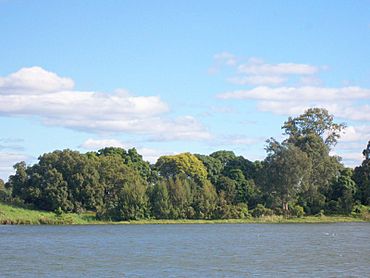Susan Island Nature Reserve facts for kids
Quick facts for kids Susan Island Nature ReserveNew South Wales |
|
|---|---|
|
IUCN Category IV (Habitat/Species Management Area)
|
|

Susan Island
|
|
| Nearest town or city | Grafton |
| Established | May 1982 |
| Area | 0.23 km2 (0.1 sq mi) |
| Managing authorities | NSW National Parks & Wildlife Service |
| Website | Susan Island Nature Reserve |
| See also | Protected areas of New South Wales |
| Geography | |
|---|---|
| Location | Clarence River |
| Administration | |
| State | New South Wales |
The Susan Island Nature Reserve is a protected nature reserve containing Susan Island, a river island, that is located in the Clarence River, in the Northern Rivers region of New South Wales in eastern Australia. The 23-hectare (57-acre) reserve is situated near Grafton. The island and reserve is a rare 16.5-hectare (41-acre) example of sub tropical lowland rainforest.
Contents
Features
Much of Australia's lowland sub tropical rainforest was cleared for housing and agriculture, leaving only small patches remaining, such as at Susan Island. The soils are alluvial, derived from the Clarence River. The average annual rainfall is a modest 1,080 millimetres (43 in), which is marginal for this type of vegetation community.
Fauna
Currently there are eleven reptile species and fifteen mammal species on the island. However, this is far less than older reports from colonial times. At certain times, the numbers of the three species of flying foxes are in excess of 100,000. The numbers of the grey-headed flying foxes appears to be increasing in recent years. Noteworthy birds occurring here are the osprey and the noisy pitta.
Flora
68 species of rainforest tree are known to grow on the island. Significant tree species include stinging tree, Moreton Bay fig, white walnut, shiny-leaved stinging tree, tulipwood and lacebark tree. The largest known yellow kamala grows up to 30 metres (98 ft) tall with a trunk diameter of 80 centimetres (31 in). And the widespread tropical Asian species white bean grows on the island at its southernmost limit of natural distribution. Australian red cedar was logged from the island, and although there was no regeneration, it was successfully reintroduced to the island in 2001 by NPWS during a modest rainforest expansion program, and is now thriving and reproducing. Rainforest regeneration programs have been put in place to encourage local rainforest species and suppress the problem of invasive weeds.
Indigenous Australians
It is likely that Indigenous Australians regularly visited the rainforest on the island for varying purposes. Such as the collection of food, medicinal purposes, and the collection of fibres for making bags and nets. The island has spiritual significance to the local Gumbaygnirr people, where it is recognised as a "Women's Site" and officially acknowledged as an Aboriginal Place under the NSW National Parks and Wildlife Act.


